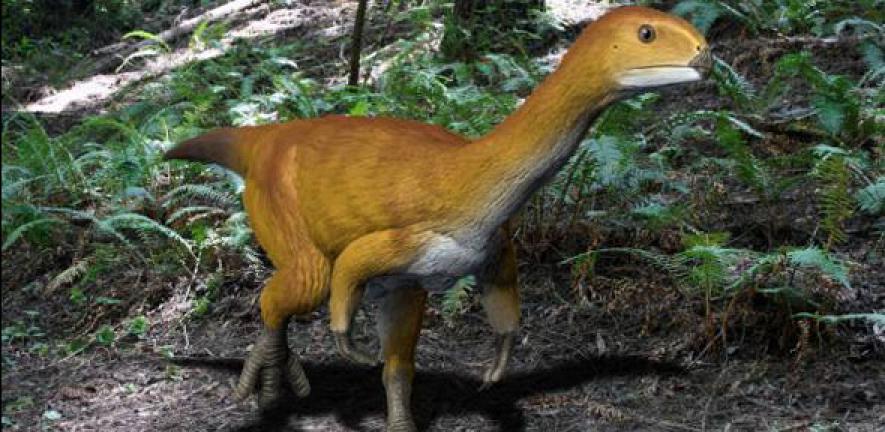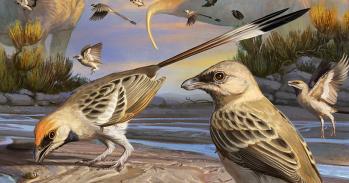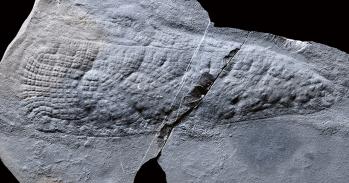
A ‘Frankenstein’s monster’ dinosaur may be the missing link between two major dinosaur groups, plugging what was previously a big gap between them.
A ‘Frankenstein’s monster’ dinosaur may be the missing link between two major dinosaur groups, plugging what was previously a big gap between them.
Chilesaurus almost looks like it was stitched together from different animals, which is why it baffled everybody.
Matthew Baron
A bizarre dinosaur which looked like a raptor but was in fact a vegetarian may be the missing link between plant-eating dinosaurs and theropods, the group that includes carnivores such as Tyrannosaurus rex and Velociraptor.
Researchers from the University of Cambridge and the Natural History Museum used a comprehensive dataset to analyse more than 450 anatomical characteristics of early dinosaurs and correctly place the creature, known as Chilesaurus, in the dinosaur family tree. Their results, reported in the journal Biology Letters, suggest that Chilesaurus effectively fills a large gap between two of the major dinosaur groups, and shows how the divide between them may have happened.
Chilesaurus, which was discovered in southern Chile, was first described in 2015. It lived during the Late Jurassic period, about 150 million years ago, and has an odd collection of physical characteristics, which made it difficult to classify. For example, its head resembles that of a carnivore, but it has flat teeth for grinding up plant matter.
“Chilesaurus almost looks like it was stitched together from different animals, which is why it baffled everybody,” said Matthew Baron, a PhD student in Cambridge’s Department of Earth Sciences and the paper’s joint first author.
Earlier research suggested that this peculiar dinosaur belonging to the group Theropoda, the ‘lizard-hipped’ group of dinosaurs that includes Tyrannosaurus, but the new study suggests that it was probably a very early member of a completely different group, called Ornithischia. This shuffling of the dinosaur family tree has major implications for understanding the origins of Ornithischia, the ‘bird-hipped’ group of dinosaurs that includes Stegosaurus, Triceratops and Iguanodon.
The bird-hipped dinosaurs have several common physical traits: the two most notable of these are an inverted, bird-like hip structure and a beak-like structure for eating. The inverted hips allowed for bigger, more complex digestive systems, which in turn allowed larger plant-eaters to evolve.
While Chilesaurus has a bird-like hip structure, and has flat teeth for grinding up plants, it does not possess the distinctive ‘beak’ of many other bird-hipped dinosaurs, which is what makes it such an important find.
“Before this, there were no transitional specimens – we didn’t know what order these characteristics evolved in,” said Baron. “This shows that in bird-hipped dinosaurs, the gut evolved first, and the jaws evolved later – it fills the gap quite nicely.”
“Chilesaurus is one of the most puzzling and intriguing dinosaurs ever discovered,” said co-author Professor Paul Barrett of the Natural History Museum. “Its weird mix of features places it in a key position in dinosaur evolution and helps to show how some of the really big splits between the major groups might have come about.”
“There was a split in the dinosaur family tree, and the two branches took different evolutionary directions,” said Baron. “This seems to have happened because of change in diet for Chilesaurus. It seems it became more advantageous for some of the meat eating dinosaurs to start eating plants, possibly even out of necessity.”
Earlier this year, the same group of researchers argued that dinosaur family groupings need to be rearranged, re-defined and re-named. In a study published in Nature, the researchers suggested that bird-hipped dinosaurs and lizard-hipped dinosaurs such as Tyrannosaurus evolved from a common ancestor, potentially overturning more than a century of theory about the evolutionary history of dinosaurs.
Although their dataset has already thrown up some surprising results, the researchers say that as it currently analyses only early dinosaurs, there are probably many more surprises about dinosaur evolution to be found, once characteristics of later dinosaurs are added.
The research was funded by the Natural Environment Research Council (NERC).
Reference:
Matthew G. Baron and Paul M. Barrett. ‘A dinosaur missing-link? Chilesaurus and the early evolution of ornithischian dinosaurs.’ Biology Letters (2017). DOI: 10.1098/rsbl.2017.0220

The text in this work is licensed under a Creative Commons Attribution 4.0 International License. For image use please see separate credits above.




